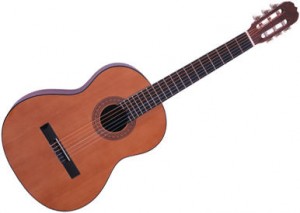Buying you first guitar can be a little intimidating. It is important to get the right guitar for you or your child because it can have a huge impact on their success. If it isn’t the right size the student will unnecessarily struggle. Getting started is hard enough with out having to struggle with a guitar that is too big!
Unfortunately, you can’t always you’re going to get good advice at the store. Most salesmen are not guitar instructors and they don’t understand the importance of a properly fitted guitar. They also probably work on commission and just want to sell you something they have in the store. I have had numerous kids show up with new guitars that were bigger then they were. Nevertheless, it is very easy to pick the right guitar.
Here are 3 things you should be sure to do:
1. Decide on the type of guitar you want.
A.) Classical Guitar
- Comes in many sizes.
- Uses nylon strings which are easy on the fingers.
- Unless you are studying classical guitar, you will most likely need to have strap buttons installed.
- Necks tend to be wider.
- Light body weight.
B.) Steel String Acoustic
- Comes in many sizes.
- Steel strings are harder on the fingers.
- Most often only have one strap button installed.
- Have narrower necks than classical guitars.
- Light body weight.
C.) Electric Guitar
- Comes in many sizes.
- Uses steel strings but are easier on the fingers than steel string acoustics.
- Will have two strap buttons already.
- Small neck circumference.
- Is the heaviest of all of the three.
- Needs and amplifier as well.
*Contrary to popular belief there is no style that is better to start on. If you don’t have a preference my recommendation is start with either nylon string guitars or electric guitars because the strings are easiest to press down. Make it easy on yourself. If you are on a budget go with the nylon string.
*Here is website that specializes in Small Guitars. It is very informative and has lots to choose from.
**Or, visit my eStore to see what I recommend to all my students, as well as, all the guitar related products and I accessories that I use and recommend!
3. Check the quality. At the beginner range you’re not going to get a lot of quality but there are some basic flaws you can try to avoid.
- Excessively buzzy strings- If you can’t play at all have the salesman do it. Ask him to play all the frets on all 6 strings. If he can’t do it he shouldn’t be selling guitars!
- Jagged frets on the edges of the neck- wrap your hand around the neck and slide it up and down a bit. You’ll know. A lot of beginner guitars have jagged fret edges. If it is a good music store they will have a guitar repair guy, called a luthier, and he can easily fix this flaw. They should be willing to have him do it free of charge if not choose another guitar with out the problem or go somewhere else.
4. Don’t forget to get your accessories: Guitar Accessories You Should Have
I hope this is helpful to anyone just getting started or thinking of taking up the guitar. Please also check out my blogs on how to get started playing. And feel free to post a comment if you have any questions, I would be happy to help out.
 Copyright secured by Digiprove © 2014 jeff lauffer
Copyright secured by Digiprove © 2014 jeff lauffer


Jagged fret edges? Like sticking out a little from the side? Also, I saw really worn frets on an old guitar; so much so that the “action” was so high it was difficult for me to get clear sounds (get my finger up against the fret enough).
Yes, some times the wood shrinks a little on cheaper guitars and the frets are left sticking out just enough so the high E can get stuck under it or even cut your finger!
The first guitar is the best thing or worst mistake much time and I made the worst mistake though. I have read this all article and get to know what mistake I have made while buying my first guitar. Helpful information saving this for future use, Thanks for sharing.